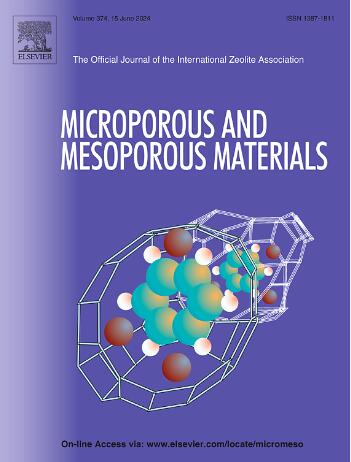Phenol hydroxylation to produce dihydroxybenzenes over iron-containing UZM-35 catalysts prepared via different methods
IF 4.7
3区 材料科学
Q1 CHEMISTRY, APPLIED
引用次数: 0
Abstract
The chemical state of iron active centers directly influences the inherent catalytic capability of iron-based zeolites. Hence, it is very important to build highly active iron species with a single coordination state through different synthetic schemes from the perspectives of both the theoretical research and practical application. Nevertheless, the identification of dominant active sites in iron-based zeolite-catalyzed phenol hydroxylation remains ambiguous, primarily due to the heterogeneous nature of iron speciation within the zeolitic framework. In this study, iron-based UZM-35 zeolite catalysts with different coordination states were obtained by three different preparation methods using UZM-35 zeolite as the supports. A comprehensive characterization of the catalysts' structure and properties was performed using SEM, XRD, FT-IR, Raman, N2 physisorption, H2-TPR, UV–Vis and NH3-TPD. The findings indicate that Fe-UZM-35 zeolite prepared via the direct synthesis method predominantly contains isolated tetrahedrally coordinated framework Fe3+ ion species, whereas Fe/UZM-35 zeolites produced via impregnation and solid-state ion exchange methods primarily consist of octahedrally coordinated isolated extra-framework Fe3+ ion species. The data from the catalytic reaction showed that Fe/UZM-35 zeolite catalysts prepared by two post-treatment methods had good activity for phenol hydroxylation, while the dihydroxybenzene selectivity of solid-state ion exchange method was slightly higher than that of impregnation method. As the iron content rose, the selectivity for dihydroxybenzene increased progressively. The sample of G-6wt%Fe/UZM-35 reached a phenol conversion of 53.65 % and a dihydroxybenzene selectivity of 89.93 % (SCAT = 46.95 %, SHQ = 42.99 %). Moreover, it was observed that light irradiation affected the dynamics of phenol hydroxylation reaction, resulting in diminished selectivity toward dihydroxybenzene while concomitantly enhancing tar formation. According to the findings from structural analysis and assessment of catalytic performance, we proposed that the octahedral coordinated isolated extra-framework Fe3+ ion species have higher hydroxylation activity and dihydroxybenzene selectivity in the phenol hydroxylation reaction catalyzed by iron-based zeolites.

不同方法制备的含铁UZM-35催化剂上苯酚羟基化制备二羟基苯
铁活性中心的化学状态直接影响铁基沸石的内在催化性能。因此,从理论研究和实际应用的角度来看,通过不同的合成方案来构建具有单一配位态的高活性铁具有重要的意义。然而,铁基沸石催化苯酚羟基化的主要活性位点的鉴定仍然不明确,主要是由于沸石框架内铁形态的异质性。本研究以UZM-35沸石为载体,通过三种不同的制备方法,得到了具有不同配位态的铁基UZM-35沸石催化剂。采用SEM、XRD、FT-IR、Raman、N2物理吸附、H2-TPR、UV-Vis和NH3-TPD对催化剂的结构和性能进行了全面表征。结果表明,直接合成法制备的Fe-UZM-35分子筛主要含有孤立的四面体配位框架Fe3+离子,而浸染法和固相离子交换法制备的Fe/UZM-35分子筛主要由八面体配位分离的框架外Fe3+离子组成。催化反应数据表明,两种后处理方法制备的Fe/UZM-35沸石催化剂对苯酚羟基化反应均有较好的活性,而固态离子交换法对二羟基苯的选择性略高于浸渍法。随着铁含量的增加,对二羟基苯的选择性逐渐提高。G-6wt%Fe/UZM-35的苯酚转化率为53.65%,对二羟基苯的选择性为89.93% (SCAT = 46.95%, SHQ = 42.99%)。此外,还观察到光照射会影响苯酚羟基化反应的动力学,导致对二羟基苯的选择性降低,同时促进焦油的形成。根据结构分析和催化性能评价结果,我们提出在铁基沸石催化的苯酚羟基化反应中,八面体配位分离的框架外Fe3+离子具有较高的羟基化活性和对二羟基苯的选择性。
本文章由计算机程序翻译,如有差异,请以英文原文为准。
求助全文
约1分钟内获得全文
求助全文
来源期刊

Microporous and Mesoporous Materials
化学-材料科学:综合
CiteScore
10.70
自引率
5.80%
发文量
649
审稿时长
26 days
期刊介绍:
Microporous and Mesoporous Materials covers novel and significant aspects of porous solids classified as either microporous (pore size up to 2 nm) or mesoporous (pore size 2 to 50 nm). The porosity should have a specific impact on the material properties or application. Typical examples are zeolites and zeolite-like materials, pillared materials, clathrasils and clathrates, carbon molecular sieves, ordered mesoporous materials, organic/inorganic porous hybrid materials, or porous metal oxides. Both natural and synthetic porous materials are within the scope of the journal.
Topics which are particularly of interest include:
All aspects of natural microporous and mesoporous solids
The synthesis of crystalline or amorphous porous materials
The physico-chemical characterization of microporous and mesoporous solids, especially spectroscopic and microscopic
The modification of microporous and mesoporous solids, for example by ion exchange or solid-state reactions
All topics related to diffusion of mobile species in the pores of microporous and mesoporous materials
Adsorption (and other separation techniques) using microporous or mesoporous adsorbents
Catalysis by microporous and mesoporous materials
Host/guest interactions
Theoretical chemistry and modelling of host/guest interactions
All topics related to the application of microporous and mesoporous materials in industrial catalysis, separation technology, environmental protection, electrochemistry, membranes, sensors, optical devices, etc.
 求助内容:
求助内容: 应助结果提醒方式:
应助结果提醒方式:


